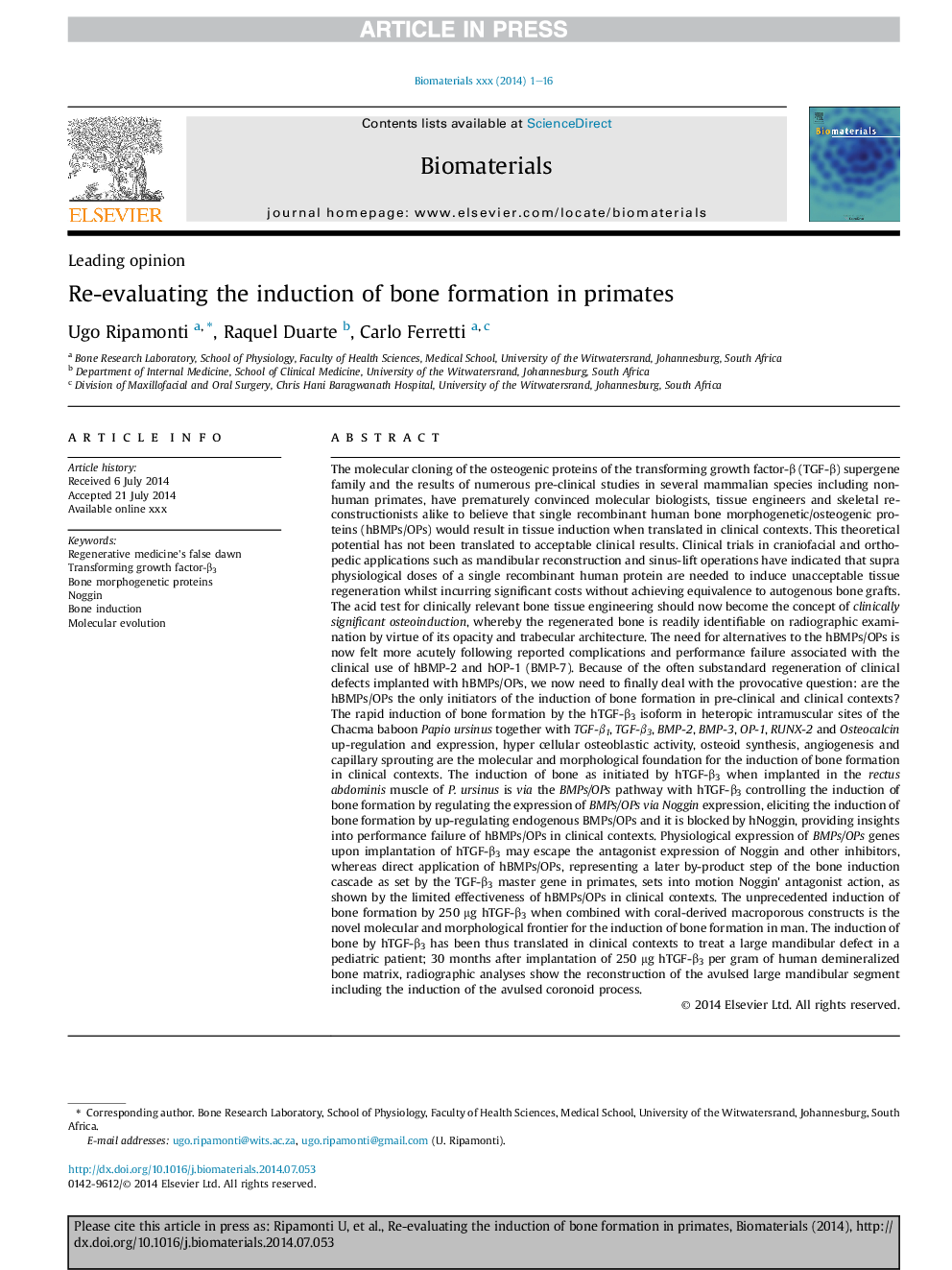| کد مقاله | کد نشریه | سال انتشار | مقاله انگلیسی | نسخه تمام متن |
|---|---|---|---|---|
| 10227267 | 434 | 2014 | 16 صفحه PDF | دانلود رایگان |
عنوان انگلیسی مقاله ISI
Re-evaluating the induction of bone formation in primates
ترجمه فارسی عنوان
دوباره ارزیابی القای استخوان در پرایات
دانلود مقاله + سفارش ترجمه
دانلود مقاله ISI انگلیسی
رایگان برای ایرانیان
کلمات کلیدی
طلوع غلط داروهای تجدید پذیر، تبدیل فاکتور رشد - Î3، پروتئین های مورفوژنیک استخوان، نگگین، القاء استخوان، تکامل مولکولی،
موضوعات مرتبط
مهندسی و علوم پایه
مهندسی شیمی
بیو مهندسی (مهندسی زیستی)
چکیده انگلیسی
The molecular cloning of the osteogenic proteins of the transforming growth factor-β (TGF-β) supergene family and the results of numerous pre-clinical studies in several mammalian species including non-human primates, have prematurely convinced molecular biologists, tissue engineers and skeletal reconstructionists alike to believe that single recombinant human bone morphogenetic/osteogenic proteins (hBMPs/OPs) would result in tissue induction when translated in clinical contexts. This theoretical potential has not been translated to acceptable clinical results. Clinical trials in craniofacial and orthopedic applications such as mandibular reconstruction and sinus-lift operations have indicated that supra physiological doses of a single recombinant human protein are needed to induce unacceptable tissue regeneration whilst incurring significant costs without achieving equivalence to autogenous bone grafts. The acid test for clinically relevant bone tissue engineering should now become the concept of clinically significant osteoinduction, whereby the regenerated bone is readily identifiable on radiographic examination by virtue of its opacity and trabecular architecture. The need for alternatives to the hBMPs/OPs is now felt more acutely following reported complications and performance failure associated with the clinical use of hBMP-2 and hOP-1 (BMP-7). Because of the often substandard regeneration of clinical defects implanted with hBMPs/OPs, we now need to finally deal with the provocative question: are the hBMPs/OPs the only initiators of the induction of bone formation in pre-clinical and clinical contexts? The rapid induction of bone formation by the hTGF-β3 isoform in heteropic intramuscular sites of the Chacma baboon Papio ursinus together with TGF-β1, TGF-β3, BMP-2, BMP-3, OP-1, RUNX-2 and Osteocalcin up-regulation and expression, hyper cellular osteoblastic activity, osteoid synthesis, angiogenesis and capillary sprouting are the molecular and morphological foundation for the induction of bone formation in clinical contexts. The induction of bone as initiated by hTGF-β3 when implanted in the rectus abdominis muscle of P. ursinus is via the BMPs/OPs pathway with hTGF-β3 controlling the induction of bone formation by regulating the expression of BMPs/OPs via Noggin expression, eliciting the induction of bone formation by up-regulating endogenous BMPs/OPs and it is blocked by hNoggin, providing insights into performance failure of hBMPs/OPs in clinical contexts. Physiological expression of BMPs/OPs genes upon implantation of hTGF-β3 may escape the antagonist expression of Noggin and other inhibitors, whereas direct application of hBMPs/OPs, representing a later by-product step of the bone induction cascade as set by the TGF-β3 master gene in primates, sets into motion Noggin' antagonist action, as shown by the limited effectiveness of hBMPs/OPs in clinical contexts. The unprecedented induction of bone formation by 250 μg hTGF-β3 when combined with coral-derived macroporous constructs is the novel molecular and morphological frontier for the induction of bone formation in man. The induction of bone by hTGF-β3 has been thus translated in clinical contexts to treat a large mandibular defect in a pediatric patient; 30 months after implantation of 250 μg hTGF-β3 per gram of human demineralized bone matrix, radiographic analyses show the reconstruction of the avulsed large mandibular segment including the induction of the avulsed coronoid process.
ناشر
Database: Elsevier - ScienceDirect (ساینس دایرکت)
Journal: Biomaterials - Volume 35, Issue 35, November 2014, Pages 9407-9422
Journal: Biomaterials - Volume 35, Issue 35, November 2014, Pages 9407-9422
نویسندگان
Ugo Ripamonti, Raquel Duarte, Carlo Ferretti,
